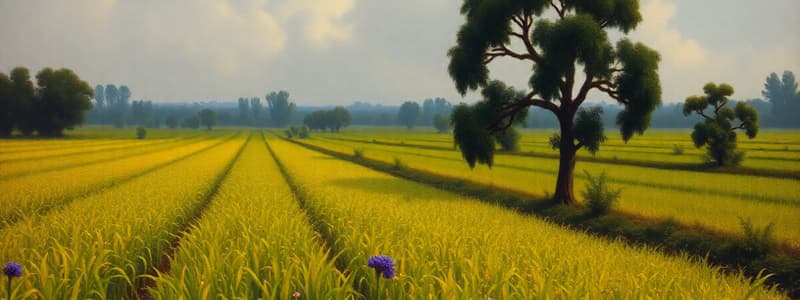Podcast
Questions and Answers
What is the main reason for India's import substitution policy?
What is the main reason for India's import substitution policy?
- To enable free trade with other countries.
- To increase the availability of imported goods.
- To reduce dependence on foreign goods and promote domestic industries. (correct)
- To lower prices of imported goods.
Which of these is NOT an objective of Indian Five-Year Plans?
Which of these is NOT an objective of Indian Five-Year Plans?
- Privatisation (correct)
- Self-sufficiency
- Growth
- Modernisation
What is a major criticism of the public sector in India's industrial development during the planning period?
What is a major criticism of the public sector in India's industrial development during the planning period?
- It became inefficient and incurred significant losses. (correct)
- It was too focused on profit generation.
- It was too heavily reliant on foreign investment.
- It lacked the necessary technological expertise.
What is one reason why India has not witnessed a significant decline in the proportion of people depending on agriculture?
What is one reason why India has not witnessed a significant decline in the proportion of people depending on agriculture?
What is the main goal of "growth with equity" as a planning objective?
What is the main goal of "growth with equity" as a planning objective?
Why was self-reliance considered a crucial objective for India's Five-Year Plans?
Why was self-reliance considered a crucial objective for India's Five-Year Plans?
What is the "marketable surplus" in agriculture?
What is the "marketable surplus" in agriculture?
How did the Green Revolution enable the government to procure sufficient food grains?
How did the Green Revolution enable the government to procure sufficient food grains?
What is a key question addressed by India's five-year plans?
What is a key question addressed by India's five-year plans?
What is a suggested activity for students to understand agricultural practices in India?
What is a suggested activity for students to understand agricultural practices in India?
What is a potential focus of a class discussion related to agriculture and international organizations?
What is a potential focus of a class discussion related to agriculture and international organizations?
What might a pie chart comparing occupational structures in India's economy in 1950-51 and a later period reveal?
What might a pie chart comparing occupational structures in India's economy in 1950-51 and a later period reveal?
What might a class discussion about the Indian economy aim to achieve?
What might a class discussion about the Indian economy aim to achieve?
Which of the following is NOT a key question that India's five-year plans attempt to address?
Which of the following is NOT a key question that India's five-year plans attempt to address?
What aspect of agricultural practices is NOT specifically mentioned as a potential focus for student research?
What aspect of agricultural practices is NOT specifically mentioned as a potential focus for student research?
What is a key reason why studying agricultural subsidies is relevant in the context of India's economic development?
What is a key reason why studying agricultural subsidies is relevant in the context of India's economic development?
Flashcards
India's Five Year Plans
India's Five Year Plans
Strategic plans aimed at economic growth and social development in India.
Regulated Economy
Regulated Economy
An economy where government regulations control production and distribution.
Agriculture Policies (1950-1990)
Agriculture Policies (1950-1990)
Guidelines and regulations governing farming practices and support in India during the specified period.
Industry Policies (1950-1990)
Industry Policies (1950-1990)
Signup and view all the flashcards
Costs of Production
Costs of Production
Signup and view all the flashcards
Marketable Surplus
Marketable Surplus
Signup and view all the flashcards
Agricultural Subsidies
Agricultural Subsidies
Signup and view all the flashcards
Occupational Structure
Occupational Structure
Signup and view all the flashcards
Mixed Economy Model
Mixed Economy Model
Signup and view all the flashcards
Five Year Plans
Five Year Plans
Signup and view all the flashcards
Green Revolution
Green Revolution
Signup and view all the flashcards
Land Reforms
Land Reforms
Signup and view all the flashcards
Import Substitution
Import Substitution
Signup and view all the flashcards
High Yielding Variety (HYV) Seeds
High Yielding Variety (HYV) Seeds
Signup and view all the flashcards
Growth with Equity
Growth with Equity
Signup and view all the flashcards
Study Notes
Indian Economy 1950-1990
- Learners will understand India's five-year plans
- Policies in sectors like agriculture and industry (1950-1990)
- Merits and limitations of a regulated economy
Introduction
- India gained independence on August 15, 1947
- Jawaharlal Nehru favoured socialism, but not the Soviet model
- Nehru and other leaders sought an alternative to extreme capitalism and socialism
Studying That Suits You
Use AI to generate personalized quizzes and flashcards to suit your learning preferences.


